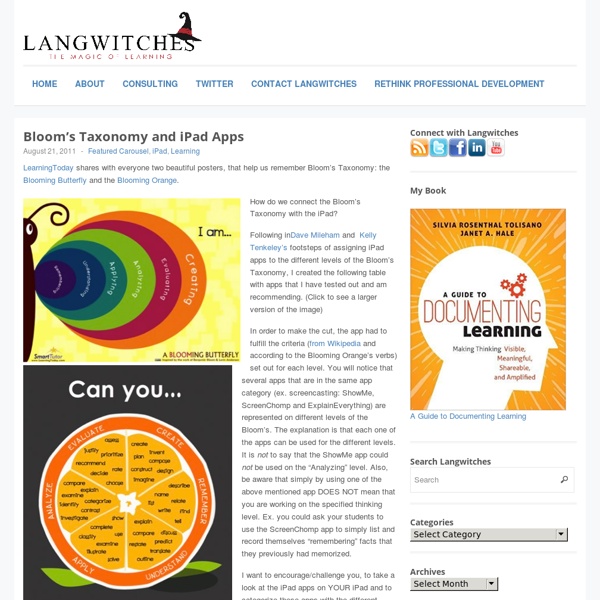48 Free Education Apps Sorted By Grade Level
5 Useful iPhone Apps For Student Bloggers 10.32K Views 0 Likes Student blogging is a wonderful way to get into the world of online writing and learning.
CSD-iAchieve
iAchieve is Creighton School District’s mobile learning initiative. The iAchieve Project has put mobile technology directly into the hands of students. Using iPads and iPod touches, provides students with enriched learning experiences, opportunities for differentiated learning, and increased achievement in many content areas. The project began with the implementation of over 700 iPod touches in third grade classrooms to positively impact oral reading fluency.
10 Free E-Book Sites for iPad
Want to get the most out of your iPad - Are you using it as an e-reader? There are multiple sites that offer free downloads of both classic and contemporary publications and the reading experience on the iPad is actually quite good. The font size, the instant access to chapters and pages and the .......all make for a positive reading experience. Coupled with this is the fact that this is about the only way to get anybody under the age of 20 to read for any length of time at all. For younger readers and kids learning to the read the interactive experience will engender a love of interaction with the written word. This is especially true of the newer types of apps that are coming out.
Fake A 21st Century Classroom
How To Fake A 21st Century Classroom by Terry Heick Ed note: This post has been updated from a 2013 post because I loved the original so much and it made some people mad, which is always good 21st century learning isn’t a trend as much as a reality. It’s 2015 (almost 2016), so whatever you’re doing in your classroom right now is technically 21st century learning.
The iPad Pedagogy Wheel
One question that often arises is how can I use this nice shiny iPad that you have given me to support teaching and learning? In a previous blog post I talked about assessment and the importance of deeper and higher thinking skills. I mentioned in that post that using Bloom’s Taxonomy is one way of getting teachers to think differently about the type of questions they are asking of their learners. When designing activities for learning, a taxonomy such as Bloom’s provides a framework that reminds of us how if we are to see learning taking place the types of thinking that needs to happen. What the Padagogy Wheel does is provide ideas to learners (and staff) the kinds of apps that can support the different kinds of thinking and learning across Blooms.
Ask3 – An iPad App for Creating Flipped Video Lessons Your Students Can Actually Respond To
Ask3 is a free iPad app from TechSmith. TechSmith is probably best known as being the company that produces Jing and Camtasia screen capture software. Ask3 is a tool that teachers can use to create short instructional videos that are shared directly to their students’ iPads. Students can use Ask3 to ask questions about the video, mark the video with drawing tools, and create their own audio comments about the video.
Only 1 iPad in the Classroom?
[for additional ELA/Reading specific apps and ideas see Reading on the iPad] Is only one iPad in a classroom worth it? This question keeps reappearing on the EC Ning and in other blog spaces. The answer is easy: YES, especially if the teacher has access to a Mac desktop or (preferably) laptop and a wifi network in the classroom. It is an even larger YES if the Mac device has the most current operating system. Having a computer to which the iPad can sync is not absolutely necessary, but it is a Best Idea.
39 Sites For Using iPads in the Classroom
Pages - Menu This Blog Linked From Here Sites to Follow Friday, October 7, 2011 39 Sites For Using iPads in the Classroom
Oppilaat ajattelemaan
Editor's note: The following is an excerpt from Thinking Through Project-Based Learning: Guiding Deeper Inquiry by Jane Krauss and Suzie Boss. It was published this month by Corwin. Take a moment and imagine a creative work environment. Don't worry about the kind of work going on. Just focus on the space. Close your eyes and picture it.
What can you do with an iPad in the classroom?
It’s a tool, it’s a tool, it’s a tool. The iPad is not going to replace teachers or ‘fix’ education. There is a cost implication that must be taken into account and only an educator will know if it is right for their students. Indeed the cost-benefit analysis for an establishment must take into account a host of factors when considering iPad use in the classroom.
Essential Apps for Teachers
Here are all the direct links to my reviews for my Apps for Teachers: App #1: Music (free) App #2: Dropbox (free) App #3: Skitch for Evernote (free)
50 resources for iPad use in the classroom
The transition to the more extensive use of technology in classrooms across the West has resulted in the integration of bring your own device (BYOD) schemes, equipping students with netbooks and tablet computers, and lessons that use social media & online services. Gesture-based technology is on the rise; according to the latest NMC Horizon Report, gesture-based technological models will become more readily integrated as a method of learning within the next few years. The iPhone, iPad, Nintendo Wii and Microsoft Xbox 360 Kinect technology are examples of these kinds of developments, and in particular, resources for Apple products in education are becoming widely available online. For teachers, some of which are just beginning to use tablets and mobile devices in class, these resources can be invaluable in promoting more interactive classrooms and understanding how best to use and control such products. Tutorials: 1.) iPads for learning: Getting started



